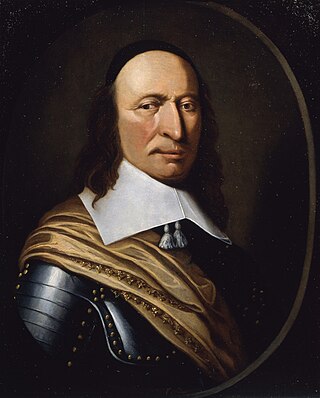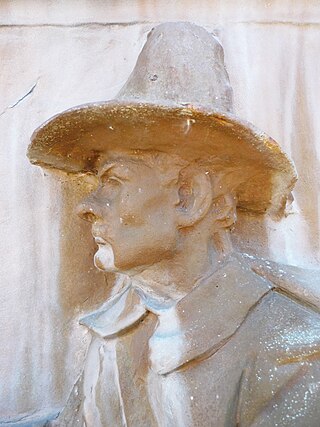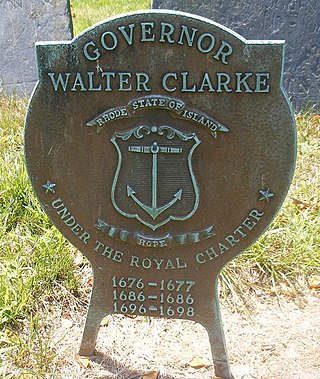Related Research Articles

Peter Stuyvesant was a Dutch colonial officer who served as the last Dutch director-general of the colony of New Netherland from 1647 until it was ceded provisionally to the English in 1664, after which it was split into New York and New Jersey with lesser territory becoming parts of other colonies, and later, states. He was a major figure in the early history of New York City and his name has been given to various landmarks and points of interest throughout the city.

New Netherland was a 17th-century colonial province of the Dutch Republic located on the east coast of what is now the United States of America. The claimed territories extended from the Delmarva Peninsula to Cape Cod. Settlements were established in what became the states of New York, New Jersey, Delaware, and Connecticut, with small outposts in Pennsylvania and Rhode Island.

John Underhill was an early English settler and soldier in the Massachusetts Bay Colony, the Province of New Hampshire, where he also served as governor; the New Haven Colony, New Netherland, and later the Province of New York, settling on Long Island. Hired to train militia in New England, he is most noted for leading colonial militia in the Pequot War (1636–1637) and Kieft's War which the colonists mounted against two different groups of Native Americans. He also published an account of the Pequot War.

New Utrecht was a town in western Long Island, New York encompassing all or part of the present-day Bath Beach, Bay Ridge, Bensonhurst, Borough Park, Dyker Heights and Fort Hamilton neighborhoods of Brooklyn, New York City. New Utrecht was established in 1652 by Dutch settlers in the Dutch colony of New Netherland, the last of the original six towns to be founded in Kings County. New Utrecht ceased to exist in 1894 when it was annexed by the City of Brooklyn, and became part of the City of Greater New York when Brooklyn joined as a borough in 1898.

The Flushing Remonstrance was a 1657 petition to Director-General of New Netherland Peter Stuyvesant, in which some thirty residents of the small settlement at Flushing requested an exemption to his ban on Quaker worship. It is considered a precursor to the United States Constitution's provision on freedom of religion in the Bill of Rights.
Philip Sherman (1611–1687) was a prominent leader and founding settler of Portsmouth in the Colony of Rhode Island and Providence Plantations. Coming from Dedham, Essex in southeastern England, he and several of his siblings and cousins settled in New England. His first residence was in Roxbury in the Massachusetts Bay Colony where he lived for a few years, but he became interested in the teachings of the dissident ministers John Wheelwright and Anne Hutchinson, and at the conclusion of the Antinomian Controversy he was disarmed and forced to leave the colony. He went with many followers of Hutchinson to establish the town of Portsmouth on Aquidneck Island, later called Rhode Island. He became the first secretary of the colony there, and served in many other roles in the town government. Sherman became a Quaker after settling in the Rhode Island colony, and died at an advanced age, leaving a large progeny.

John Bowne (1627–1695), the progenitor of the Bowne family in America, was a Quaker and an English immigrant residing in the Dutch colony of New Netherland. He is historically significant for his struggle for religious liberty.

Adriaen Cornelissen van der Donck was a lawyer and landowner in New Netherland after whose honorific Jonkheer the city of Yonkers, New York, is named. Although he was not, as sometimes claimed, the first lawyer in the Dutch colony, Van der Donck was a leader in the political life of New Amsterdam, and an activist for Dutch-style republican government in the Dutch West India Company-run trading post.
Elizabeth Fones Winthrop Feake Hallett was an early settler in the Massachusetts Bay Colony. In 1640 Fones, with her then-husband Robert Feake, were founders of Greenwich, Connecticut.
Henry Townsend was an early settler of the American Colonies.
John Townsend was an early settler of the American Colonies who emigrated from England before 1642 when his son, Thomas, was baptized at the Dutch Reformed Church in New Amsterdam. Townsend was a signatory to the Flushing Remonstrance, a precursor to the United States Constitution's provision on freedom of religion in the Bill of Rights. Because of their persecution by the Dutch authorities of New Amsterdam, he and his brother Henry supported the Quakers, and later generations of this Townsend family joined the movement. They can be found in Friends' records on Long Island, New York, Newport, Rhode Island, Cape May County, New Jersey and around Philadelphia. There is no evidence in either Warwick, Rhode Island or New York sources that John was a Quaker himself. John Townsend arrived in Oyster Bay in 1661 and he died there in 1668. There is a marker for him in Fort Hill Cemetery in the village of Oyster Bay. Members of his family would go on to be distinguished leaders in the Oyster Bay community, throughout New York State, the mid-Atlantic colonies and wherever they settled in the rest of the United States. The talented and famous furniture makers of Newport, Rhode Island Job, Christopher, John and Edmund descend from him.

Walter Clarke (1640–1714) was an early governor of the Colony of Rhode Island and Providence Plantations and the first native-born governor of the colony. The son of colonial President Jeremy Clarke, he was a Quaker like his father. His mother was Frances (Latham) Clarke, who is often called "the Mother of Governors." While in his late 20s, he was elected as a deputy from Newport, and in 1673 was elected to his first of three consecutive terms as assistant. During King Philip's War, he was elected to his first term as governor of the colony. He served for one year in this role, dealing with the devastation of the war, and with the predatory demands of neighboring colonies on Rhode Island territory during the aftermath of the war.
William Freeborn (1594–1670) was one of the founding settlers of Portsmouth on Aquidneck Island, having signed the Portsmouth Compact with 22 other men while still living in Boston. Coming from Maldon in Essex, England, he sailed to New England in 1634 with his wife and two young daughters, settling in Roxbury in the Massachusetts Bay Colony. He soon moved to Boston where he became interested in the preachings of the dissident ministers John Wheelwright and Anne Hutchinson, and following their banishment from the colony during the Antinomian Controversy, he joined many of their other followers in Portsmouth.
William Dyer was an early settler of the Colony of Rhode Island and Providence Plantations, a founding settler of both Portsmouth and Newport, and Rhode Island's first Attorney General. He is also notable for being the husband of the Quaker martyr Mary Dyer, who was executed for her Quaker activism. Sailing from England as a young man with his wife, Dyer first settled in Boston in the Massachusetts Bay Colony, but like many members of the Boston church, he became a supporter of the dissident ministers John Wheelwright and Anne Hutchinson during the Antinomian Controversy, and signed a petition in support of Wheelwright. For doing this, he was disenfranchised and disarmed, and with many other supporters of Hutchinson, he signed the Portsmouth Compact, and settled on Aquidneck Island in the Narragansett Bay. Within a year of arriving there, he and others followed William Coddington to the south end of the island, where they established the town of Newport.
John Throckmorton, Gent. (1601–1684) was an early settler of Providence Plantation in what became the Colony of Rhode Island and Providence Plantations, and he was one of the 12 original proprietors of that settlement. He emigrated from Norfolk, England to settle in Salem in the Massachusetts Bay Colony, but religious tensions brought about his removal to Providence.
George Gardiner, sometimes spelled Gardner, was an early inhabitant of Newport in the Colony of Rhode Island and Providence Plantations, and one of the original settlers of Aquidneck Island. He held some minor offices within the colony in the early 1640s, shortly after which he began a common-law marriage with Herodias (Long) Hicks, who came to live with him after separating from her first husband. This relationship lasted for nearly 20 years, after which Herodias petitioned the court to have Gardiner leave her alone, and she left Newport to go west of the Narragansett Bay and live with John Porter, a land-rich settler who was one of the original purchasers of the Pettaquamscutt lands.
Herodias Gardiner, born Herodias Long, was the wife of three early settlers of the Colony of Rhode Island and Providence Plantations, and was also a zealous Quaker evangelist who was whipped in Massachusetts for sharing her religious testimony with others in her former home town of Weymouth. She married at the age of 13 or 14 in London, she was unhappily brought to the American colonies by her first husband, John Hicks, where they settled in Weymouth. The couple had two known children, and moved to the Rhode Island Colony, but she soon separated from her husband, and looking for maintenance, settled in Newport with George Gardiner, with whom she lived for about 20 years as his common-law wife.

Thomas or Tomys Swartwout was one of the earliest importers of tobacco from New Netherland to western and northern Europe, one of earliest settlers of New Netherland, and a founder of Midwood, Brooklyn, New York.
Roelof Swartwout was a landowner, schout/magistrate, early settler of New Netherland, and the founder of Kingston, New York, and Hurley, New York.
Francis Weekes, also spelled Wickes, was a founding settler of Providence in what would become the Colony of Rhode Island and Providence Plantations.
References
- 1 2 3 4 5 6 7 Henry D. Waller (1899). A History of the Town of Flushing, Long Island, New York. New York: J.H. Ridenour.
- 1 2 Alfred Andrews (1875). Genealogical History of Deacon Stephen Hart and His Descendants, 1632-1875; With an Introduction of Miscellaneous Harts and Their Progenitors. New Britain, Connecticut: Hart, Austin. p. 10.
- 1 2 3 4 5 Purcell B. Robertson (1973). Profiles of the signers of the Flushing Remonstrance, December 27, 1657 (Typescript). Queens Public Library, New York, NY.
{{cite book}}: CS1 maint: location missing publisher (link) - ↑ Henry Whittemore (1898). Genealogical Guide to the Early Settlers of America: With a Brief History of Those of the First Generation and References to the Various Local Histories, and Other Sources of Information where Additional Data May be Found. Genealogical Publishing Com. p. 240. ISBN 978-0-8063-0378-9.
- ↑ Charles Henry Pope (1900). The pioneers of Massachusetts, a descriptive list, drawn from records of the colonies, towns and churches and other contemporaneous documents. Boston: C. H. Pope. p. 215.
- ↑ Frank R. Holmes (1964). Directory of the ancestral heads of New England families, 1620-1700. Genealogical Pub. Co. ISBN 9780806301822.
- ↑ Richard Mather Bayles (1891). History of Providence County, Rhode Island. W. W. Preston. p. 146.
- 1 2 William Read Staples (1843). Annals of the Town of Providence: From Its First Settlement, to the Organization of the City Government, in June, 1832. Knowles and Vose. p. 35.
- 1 2 John Osborne Austin (1887). The Genealogical Dictionary of Rhode Island: Comprising Three Generations of Settlers who Came Before 1690, with Many Families Carried to the Fourth Generation. Genealogical Publishing Com. pp. 314–315. ISBN 978-0-8063-0006-1.
- 1 2 Clarence Almon Torrey (1985). New England Marriages Prior to 1700. Genealogical Publishing Com. p. 348. ISBN 978-0-8063-1102-9.
- 1 2 3 4 5 Clara Hart Kennedy (1939). Edward Hart, Descendants and Allied Families. Bloomington, Ill.: Printed for the author by Wm. B. Straube Printing Co.
- 1 2 Howard M. Chapin (1916). Documentary History of Rhode Island. Norwood, Mass.: Printed for the author by the Plimpton Press. p. 119.
- 1 2 3 "Laws and ordinances of New Netherland, 1638-1674/1645". Wikisource. Retrieved 2015-08-12.
- ↑ Peter Ross (1902). A History of Long Island, From Its Earliest Settlement to the Present Time. New York: Lewis Publishing Company. p. 528.
- 1 2 3 4 5 6 7 8 9 10 11 12 13 14 15 16 17 18 19 20 21 22 B. Fernow (1883). Documents Relating to the History of the Early Colonial Settlements Principally on Long Island, in Documents Relative to the Colonial History of the State of New-York, Vol. XIV (Old Series), Vol. III (New Series). Albany, New York: Weed, Parsons, printers.
- 1 2 Albert E. McKinley (October 1900). "The English and Dutch Towns of New Netherland". American Historical Review. American Historical Association. 6 (1): 1–18. doi:10.2307/1834686. JSTOR 1834686 . Retrieved 2015-08-15.
- 1 2 3 4 5 6 7 8 Frederick James Zwierlein (1910). Religion in New Netherland, 1623-1664: A History of the Development of the Religious Conditions in the Province of New Netherland 1623-1664. J. P. Smith. pp. 164–167.
dissenting sect, the Quakers, began to proselytize among them. To Stuyvesant, the Quakers were both a political and a religious threat. In 1657, calling them "seducers of the people, who are destructive unto magistracy and ministry," he began a merciless persecution of them.
- 1 2 Henry Reed Stiles (1895). The Stiles Family in America: Genealogies of the Connecticut Family. Descendants of John Stiles, of Windsor, Conn., and of Mr. Francis Stiles, of Windsor and Stratford, Conn., 1635-1894. Doan & Pilson, printers. pp. 36–38.
The previous experience of this class of Flushing settlers in civil and political liberty, and their sturdy independence, naturally led them to resist and encroachments of the Dutch Governor and his Council upon what they considered to be their vested rights; and to refuse to render to the Colony any assistance other than that nominated in the bond of their charter. Having felt the keen blasts of proscription and outlawry on account of their religious views, and having sought this place as a permanent refuge, relying upon the well accredited liberality of the government of Holland, which had purchased for its subjects the price of religious liberty at a terrible cost of blood and treasure, and which was disposed to accord the privileges it had gained to the oppressed of every nation—the people of Flushing were surprised to find, within three years from the date of their charter, that Governor Kieft was about to enforce upon them arbitrary and uncalled for restrictions in civil matters, as well as to impose upon them the maiutaiuance of a minister of the Reformed (State) Dutch Church. As his support would have to be made a tax upon the people, the Quakers resisted; and in this they were evidently joined by the English element in the community.
- 1 2 3 4 Frederick W. Bailey (1894). The Ancestry of the Hon. John Hart, of Hopewell, N.J., Signer of the Declaration of Independence, in The New York Genealogical and Biographical Record. New York Genealogical and Biographical Society. p. 171.
- 1 2 3 E.B. O'Callaghan (1865). Calendar of historical manuscripts in the office of the secretary of state, Albany, N.Y. Albany, N.Y.: Weed, Parsons and Co.
- 1 2 Edward Tanjore Corwin (1901). Ecclesiastical Records, State of New York. J. B. Lyon, state printer. p. 226.
- 1 2 no by-line (1838). "The Early Settlement and Persecution of Friends in America". Friends' Intelligencer. New York: Isaac T. Hopper. 1 (1): 54–59, 83–87, 102–103.
- ↑ Kenneth T. Jackson; Lisa Keller; Nancy Flood (2010). The Encyclopedia of New York City: Second Edition. Yale University Press. p. 461. ISBN 978-0-300-18257-6.
- ↑ James Pierce Root (1890). Steere Genealogy: A Record of the Descendants of John Steere, who Settled in Providence, Rhode Island, about the Year 1660, with Some Account of the Steeres of England. Printed at the Riverside Press. pp. 175–179.
- 1 2 James Bowden (1850). The History of the Society of Friends in America. Charles Gilpin. p. 317.
- 1 2 Tabetha Garman (2006). Designed for the Good of All; The Flushing Remonstrance and Religious Freedom in America (PDF) (M.A.). East Tennessee State University. Archived from the original (PDF) on 2015-12-19. Retrieved 2015-08-15.
- 1 2 John Romeyn Brodhead (1853). History of the State of New York. Harper & Brothers. p. 636.
An English ship, the " Woodhouse," arrived at New Amsterdam, with a number of Quakers on board, among whom were several of those who had been banished from Boston the previous autumn. Two of these persons, Dorothy Waugh and Mary Witherhead, began to preach publicly in the streets, for which breach of the law they were arrested and imprisoned. A few days afterwards they were discharged; and the ship, with most of her Quaker passengers, sailed onward, through Hell-gate, to Rhode Island, "where all kinds of scum dwell, for it is nothing else than a sink for New England."
But Robert Hodgson, one of the Quakers, wishing to remain in the Dutch province, went over to Long Island. At Flushing he was well received. On visiting Heemstede, however, where Denton, the Presbyterian clergyman, ministered, Hodgson was arrested and committed to prison, whence he was transferred to the dungeon of Fort Amsterdam. Upon his examination before the council, he was convicted, and sentenced to labor two years at a wheelbarrow, along with a negro, or pay a fine of six hundred guilders. After a few days confinement, he was chained to a barrow, and ordered to work; and upon his refusal, was beaten by a negro with a tarred rope until he fell down. At length, after frequent scourgings and solitary imprisonments, the suffering Quaker was liberated, at the intercession of the director's sister, Anna, widow of Nicholas Bayard, and ordered to leave the province. - ↑ Frederick J. Zwierlein (July 1918). "New Netherland Intolerance". Catholic Historical Review. Catholic University of America Press. 4 (2): 186–216. JSTOR 25011564.
- 1 2 Dennis J. Maika (Winter 2008). "Commemoration and Context: The Flushing Remonstrance Then and Now". New York History. New York State Historical Association. 89 (1): 28–42. JSTOR 23183505.
- ↑ R. Ward Harrington (Fall 1993). "Speaking Scripture: The Flushing Remonstrance of 1657". Quaker History. Friends Historical Association. 82 (2): 104–109. doi:10.1353/qkh.1993.0010. JSTOR 41947247. S2CID 162058250.
The Flushing Remonstrance of 1657 provides an unusually rich display of rhetoric and fine English style, and concretely illustrates the seventeenth century practice of speaking Scripture. This practice consists of an outpouring of ministry in which words and phrases of Scripture are woven into the discourse with no mention of "chapter or verse," but in a manner by which they can be clearly identified as Scripture. The ministry of George Fox displays this feature but the Flushing Remonstrance is an unusually concentrated illustration of it. In these ministers, Scripture had been so thoroughly assimilated that its words and phrases became a part of the person. What follows is the text of the Flushing Remonstrance with the Biblical phrases identified by chapter and verse in the King James Version. This compilation may not exhaust the Biblical elements to be found in the Remonstrance, but it suggests the possibilities.
- ↑ "The Text of the Flushing Remonstrance" (PDF). Paper presented to the Center for Ethical Culture, November 15, 2007. Archived from the original (PDF) on 2015-12-19. Retrieved 2015-08-16.
- ↑ "Sketch of the Family of Field". The New England Historical and Genealogical Register. New England Historic Genealogical Society. 17: 110–111. April 1863.
There is little doubt therefore that Robert Field came to New England in 1630 ...John Hicks, and they are again mentioned in the court roll of freemen dated March 16th, 1641, but neither appears in the Newport list of 1655. It is stated by Sec. Tieuhoven (vide Doc. Hist, of New York), that the Mespocht patent, embracing most of the land around Flushing and Hampstead, was granted to the Rev. Francis Doughty "for himself and his associates, whose agent he was, and who at the time were residing at Rhode Island." When we take these facts into consideration, and again find the names of Robert Field and John Hicks together in the Flushing patent of 1645, there can not be much doubt that they were the two former residents of Newport.
- ↑ Paul Finkelman (2003). Baptists in Early America and the Separation of Church and State, in Religion and American Law: An Encyclopedia. Routledge. p. 22. ISBN 978-1-136-91956-5.
- ↑ David Voorhees. "The 1657 Flushing Remonstrance in Historical Perspective" (PDF). Keynote speech of the New York State History Conference, 2007. Archived from the original (PDF) on 2016-03-06. Retrieved 2015-08-16.
- 1 2 3 4 5 Edmund Bailey O'Callaghan (1865). The register of New Netherland, 1626 to 1674. Albany, N.Y.: J. Munsell.
- 1 2 3 E.B. O'Callaghan (1868). Laws and ordinances of New Netherland, 1638-1674. Albany, N.Y.: Weed, Parsons and Co.
- ↑ Evan Haefeli (8 April 2013). New Netherland and the Dutch Origins of American Religious Liberty. University of Pennsylvania Press. ISBN 978-0-8122-0895-5.
- 1 2 "Register of Salomon La Chair, Notary Public at New Amsterdam 1661-1662". Year Book of the Holland Society of New York. Holland Society of New York. 1900.
- 1 2 Charles Wyman Hopkins (1 June 2009). The Home Lots of the Early Settlers of the Providence Plantations. Genealogical Publishing Com. p. 53. ISBN 978-0-8063-4680-9.
- 1 2 Providence (R.I.). Record Commissioners (1909). The early records of the town of Providence. Snow & Farnham, city printers. p. 213.
- 1 2 James N. Arnold (1996). The Narragansett Historical Register. Heritage Books. p. 270. ISBN 978-0-7884-0536-5.
- 1 2 William Smith Pelletreau (1898). Early Wills of Westchester County, New York, from 1664 to 1784. F.P. Harper. p. 187.
- ↑ Robert Bolton; Cornelius Winter Bolton; Oliver Rivington Willis (1881). The History of the Several Towns, Manors, and Patents of the County of Westchester: From Its First Settlement to the Present Time. C.F. Roper. pp. 735–736.
- ↑ History of Queens County, New York. New York: W.W. Munsell & Co. 1882.
- ↑ "The 1911 State Library Fire And Its Effect On New York Genealogy". transcribed from the New York Genealogical and Biographical Society Newsletter, Spring 1999. Archived from the original on October 7, 2006. Retrieved 2015-09-03.
- ↑ Arnold J.F. Van Laer (January 1, 1910). "The translation and publication of the manuscript Dutch records of New Netherland, with an account of previous attempts at translation". Education Department Bulletin. Albany, N.Y.: University of the State of New York.